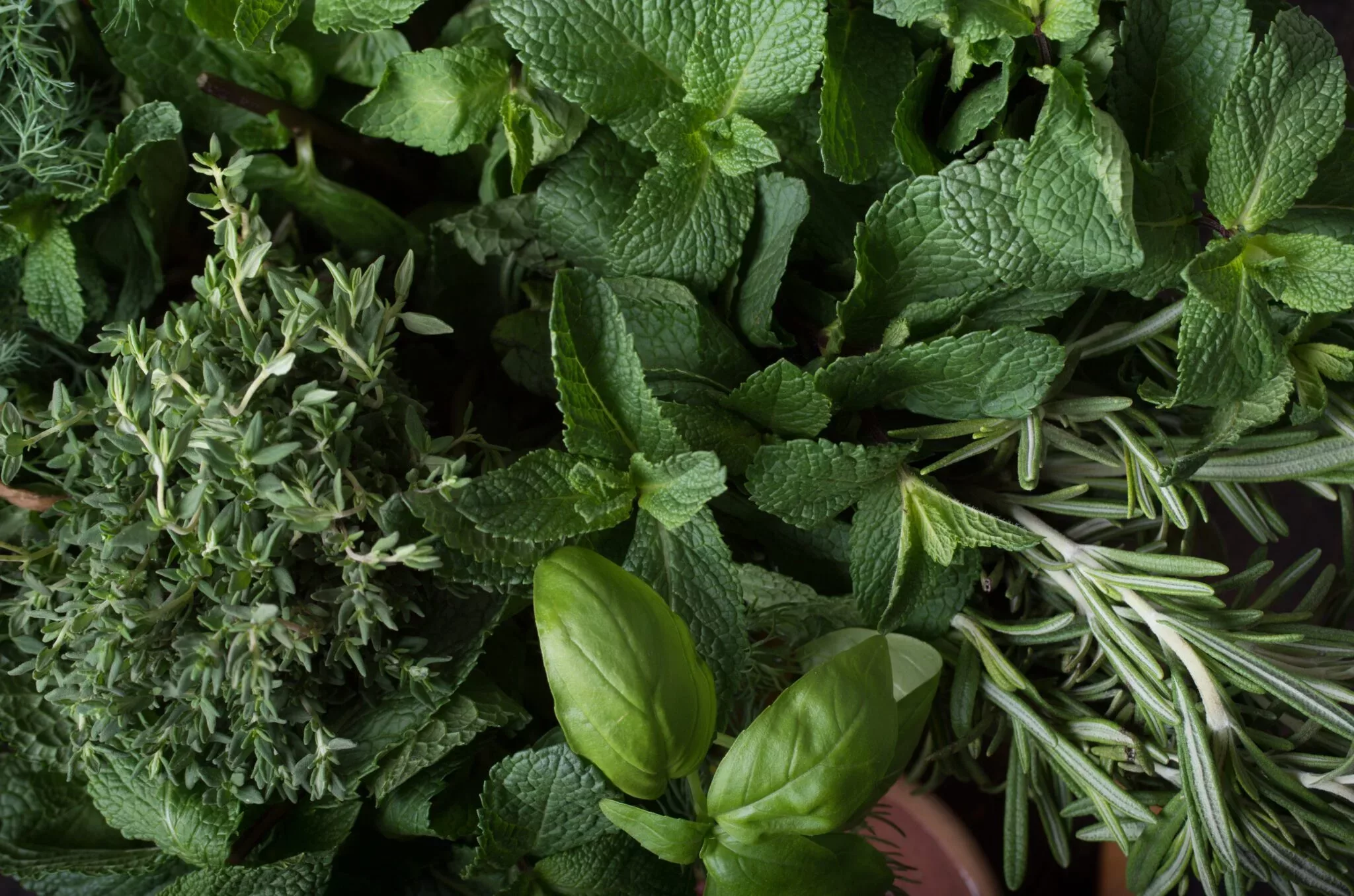Do you want to elevate your cooking with minimal work or stress? Fresh herbs are your answer! Using herbs is a delicious and easy way to enhance your at home cooking for the better. Not only are they a wonderful way to add flavor and aroma without adding extra salt, fat, or sugar to a dish, but they also contain antioxidants and phytonutrients that support health. Although they may seem intimidating at first you really can’t go wrong. Adding a handful here and there of your favorite sun-kissed, fresh herbs can make a simple meal taste extraordinary.
Is there a thriving rosemary bush in your backyard? Then make a large batch of rosemary lemonade. Did you pick up some mint for mojitos but don’t know what to do with the rest? Then add the fresh mint into smoothies, salads, toss with fruit, or top with hot water to make fresh peppermint tea. Getting familiar with the fresh herbs available in your garden, at the grocery store, and at your local farmer’s market can help you get creative on the fly!
What’s in Your Herb Garden?
BASIL: This delicate, large-leafed herb is a common staple in Italian, Indian, and Asian cuisine. It easily bruises when cut, therefore cut right before serving. Use basil in pesto, caprese salads, on sandwiches, or sprinkle fresh into foods after cooking.
CHIVE: As part of the onion family, chives have a delicate onion/garlic flavor without being too overpowering. Use these as a garnish, in dressing, and in soups for a refreshing taste.
CILANTRO: With delicate leaves, this herb is best used fresh and is often found in Mexican fare such as salsa and guacamole. Add a handful to salads, cooked rice, and dips for a boost of nutrition and flavor. But beware, not everyone is a cilantro lover! For some this flavorful herb tastes like soap.
MINT: This aromatic herb is commonly used in Greek cuisine, often paired with lamb. Mint also tastes great when combined with citrus fruit or cucumber in cooling summer beverages. Plus, it can help soothe digestion and may ease stomach cramps when served as a tea.
OREGANO: Sometimes called wild marjoram, oregano is often used to flavor Italian-American foods, pairing well with both grilled meats and veggies as well as pasta salads.
PARSLEY: Commonly used in French, Italian, and German cuisine, this tender herb can be a great addition to any meal. Simple sprinkle on anything and everything for a bit of color or blend into a creamy sauce.
ROSEMARY: This Mediterranean herb is woody with pine-like needles. It offers great flavor when used fresh in marinades and dressings or added to lemonade. It also tastes wonderful sauteed with butter and garlic and tossed with pasta!
SAGE: With soft, velvety leaves and an earthy flavor, this herb is commonly used in comfort foods during the fall and winter months. Use it with winter squash or add it into marinades for roasts.
THYME: This evergreen herb is often used in Mediterranean cuisine. Use it in combination with other herbs or alone to flavor meats and beans. Also pairs wonderfully with white fish. Top fish with fresh thyme twigs before roasting, or butter baste the fish with thyme around it.
How to Store Fresh Herbs
The best and cheapest way to store herbs is to have your own herb garden to pick from as needed. However, if you often buy your fresh herbs at the grocery store or your local farmer’s market, it is best to follow the tips below to keep them fresh as long as possible.
Wrap hardier herbs such as rosemary, thyme, and oregano in a dry paper towel and seal them in a plastic, sealable bag. Keep it in the refrigerator for optimal freshness.
Keep delicate herbs such as parsley, cilantro, basil, and chives in a mason jar filled with a little water on your counter or even in the refrigerator. Trim the herb ends with scissors and place the herb (stem and all) into the jar. The water should remain at stem height only because the leaves can quickly rot if immersed in water.
Cooking Tips
Herb Salt
Heighten the flavor and aroma of roasted vegetables, especially potatoes, with herb salt. Simply toss with olive oil, sprinkle with herb salt, and roast in the oven at 450 degrees for 20 minutes or until tender.
Sprinkle on root vegetables prior to roasting, on veggies for the grill, or on your favorite meats and fish. Or simply use in place of normal sea salt for added flavor in any dish.
Ingredients
- Handful of fresh rosemary, thyme, and oregano (or any combination of hardy herbs)
- 2-3 tablespoons fine sea salt
Method
Preparation time: 5 minutes
Makes about ¼ cup
- Pick off the herb leaves from the stems and place into a pile on a large cutting board.
- Sprinkle the sea salt (fine or coarse depending on your liking) over the fresh herbs.
- With your sharp chef’s knife, begin to finely chop the herbs into the sea salt. Continue to mince the herbs into the salt until the salt and herbs become one mass. Store in a sealable container in the refrigerator for up to 1 week.
Herb Butter
Impress your guests with an herb butter or herb marinade. Using either oil or butter enhances the absorption of the fat-soluble vitamins A and K, which are found within the plant leaves!
Use this aromatic butter to sauté lean cuts of meat, top salmon for grilling, or use as a special buttery spread for bread.
Ingredients
- 1 stick salted organic butter, room temperature
- ¼ cup finely minced fresh herbs (parsley, chives, and/or tarragon)
- 1 clove garlic, pressed (optional)
- Fresh ground pepper
Method
Preparation time: 4 minutes
Makes 1 log
- In a medium bowl mix together the butter, finely minced herbs, and pressed garlic. Add fresh ground pepper to taste. Mix well until evenly combined.
- Spoon the herb butter mixture onto parchment paper and form into a cylinder. Wrap and seal ends by twisting the parchment. Refrigerate up to 2 weeks or freeze up to a month.
Refreshing Mint Tea
Add zest and flavor to cooling beverages by adding fresh herbs such as mint and rosemary. Rub the leaves between your fingers to release the essential oils before adding them to your favorite drink. Or, make fresh herb teas!
In place of bagged peppermint tea, try using fresh mint for more aroma. If served in a glass cup, you can even admire the leaves as you drink.
Ingredients
- 2-3 large sprigs of fresh mint
- Hot boiling water
- Optional: lemon wedges and honey
Method
Preparation time: 5 minutes
Makes 1 tea
- Rub the mint leaves gentle between your fingers to release the essential oils and place into a mug.
- Pour just boiled water over the leaves to fill your favorite mug and add optional lemon and honey if desired.
- Steep the peppermint sprigs for as long as you like or just leave them in.

